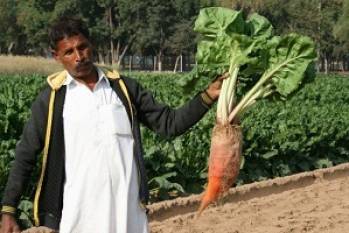JODHPUR, 12 May 2020: Providing a significant solution for the availability of green fodder for the livestock of the farmers of arid regions, the ICAR-Central Arid Zone Research Institute, Jodhpur, Rajasthan has come up with a new fodder crop, that is, Fodder Beet (Beta vulgaris), a plant that produces tubers of an average weight of 5 to 6 kgs.
The crop having a potential to produce >200 tonnes / ha green biomass in a time of 4 months, can be grown very profitably with poor quality of water and soil also. Fodder from this crop remains available between January and April when there is meager availability of other fodder crops.
With the cost of production less than 50 paisa per kilogram of biomass produced, the crop has a very high water use efficiency of 28-32 kg green biomass per m3 water. Feeding trials on Tharparkar cattle have shown 8 to 10% improvement in milk yield.
Over 600 farmers from Rajasthan tried it
The crop has been demonstrated to more than 600 farmers of Barmer, Jodhpur, Nagaur, Pali, Sirohi, Bikaner, Sikar, Jhunjhunu, Ajmer, Jaipur, Churu, Bharatpur, Sri Ganganagar, Alwar, Kota, and Bundi Districts of Rajasthan though Corporate Social Responsibility Programme with CAIRN energy, KVKs, NGOs, State Agricultural Universities, Veterinary Universities and State Government.
The package of practices of the crop has also been adopted by the Rajasthan State Department of Agriculture.
The crop is now being grown in other agro-climatic regions as well. The farmers of Madhya Pradesh, Haryana, Chhattisgarh, Maharashtra, Kerala and Uttar Pradesh have also tried and gave a positive feedback about the crop.
For higher production, the loamy soils are best, but it can also be grown successfully on salt affected soils. Appropriate time of sowing is from mid-October to mid-November.
The crop requires a fine seed bed and should be planted on ridges. The field should be ploughed 3 to 4 weeks before sowing with a soil turning plough followed by cross harrowing and planking.
Over 100,000 plants per hectare
The ridges of 20 cm height should be prepared with a bund former at a distance of 70 cm. About 2.0 to 2.5 kg seed per hectare is required for an optimum population of 1,00,000 plants per hectare.
The seeds should be sown halfway on one side of ridge at a depth of 2 to 4 cm and 20 cm distance between the plants. The important varieties are Jomon, Monroe, JK Kuber and Geronimo.
Since, many varieties are multi-germ, that is, a single seed produces 3 to 4 seedlings; so, thinning is required after 25 to 30 days.
Irrigate the field immediately after sowing. In case of flood irrigation, water in the furrows should not go beyond 2/3rd of the height of ridge or overflow. About 25 ton FYM/ha + 100 Kg N / ha + 75 kg P2 O5 / ha is recommended. If FYM is not available, the dose of fertilizer N should be increased to 150 kg / ha.
Nitrogen should be applied in three splits, that is, half at sowing and 1/4th each at 30 and 50 days after sowing (DAS). It needs 10-12 sprinkler irrigations with a total requirement of around 80 - 100 cm irrigation water.
No major disease and pest are reported
The first irrigation should be applied immediately after sowing, if crusting occurs, a light irrigation should be given just after 4 days of sowing. Later on, irrigation should be given at an interval of 10 days during November, 13 to 15 days during December to February and in 7 to 10 days during March and April.
It can profitably be grown with saline and alkaline water also. It should be done along with hand weeding and earthing up operations. If required, second weeding should be done after 15 days.
No major disease and pest are reported. However, to control soil borne insects, apply Quinalphos powder (1.5%) at the rate of 25 kg / ha before sowing.
Normally the uprooting can be started when root attains a minimum weight of about 1.0 to 1.5 kg weight (during mid-January). Accordingly, the farmers can uproot everyday as per the requirement of feed for their cattle. Since, the roots remain 60% outside soil; they can be harvested manually by pulling up.
Foliage should also be fed to the animals.
The roots of the crop can be chopped into small pieces and mixed with dry fodder. The dosages are 12 to 20 kg / animal per day to cows and buffaloes and 4 to 6 kg / animal per day to small ruminants.
Start feeding with small quantity with progressive increase so that normal feeding amount to reach by 10 days. It should not exceed 60% of total dry matter requirement of the animal.
Excess feeding may cause acidity in the animal. Don’t feed more than three days old harvested fodder. With the recommended package of practices and prevailing conditions, the green fodder yield (root + foliage) of 150 to >200 tonnes/ha can be achieved.
Image caption: A farmer holding the fodderbeet crop




















